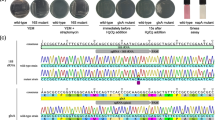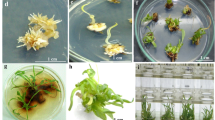Abstract
The regulatory function of global regulator NtrC on curdlan biosynthesis and nitrogen consumption under nitrogen-limited condition in Agrobacterium sp. ATCC 31749 was investigated. The ntrC mutant of Agrobacterium sp. was constructed by homologous recombination. The ability to utilize NH4Cl and KNO3 was impaired in the mutant. Other nitrogenous compounds, such as glutamic acid and glutamine, were utilized normally. Curdlan production capability was impaired severely in the mutant. Curdlan production was 5-fold lower than the wild type strain in batch fermentation with NH4Cl as the sole nitrogen source. However, up to 6.5 g l−1 of a newly found alkali-insoluble biopolymer was produced by the ntrC mutant when glutamic acid was used as nitrogen source. The new biopolymer had glycosidic bond and hydroxyl group but no β-configuration absorption peak on IR spectrum was found as different from curdlan. In addition, the mutant exhibited a rapid morphological change from the dot to rod form. These results deduced that the global regulator NtrC was involved in curdlan and other biopolymer biosynthesis in Agrobacterium sp. ATCC 31749 in response to nitrogen-limited condition.





Similar content being viewed by others
References
Anderson AJ, Dawes EA (1990) Occurrence, metabolism, metabolic role, and industrial uses of bacterial polyhydroxyalkanoates. Microbiol Rev 54:450–472
Andrew J, Leech AS (2008) The NtrC family regulator algB, which controls alginate biosynthesis in mucoid Pseudomonas aeruginosa, binds directly to the algD promoter. J Bacteriol 190:581–589
Dodsworth JA, Leigh JA (2007) Nitrogen regulation in bacteria and archaea. Annu Rev Biochem 61:349–377
Dombrecht B, Marchal K, Vanderleyden J (2002) Prediction and overview of the RpoN-regulon in closely related species of the Rhizobiales. Genome Biol 3:1–11
England JC, Perchuk BS, Laub MT, Gober JW (2010) Global regulation of gene expression and cell differentiation in Caulobacter crescentus in response to nutrient availability. J Bacteriol 192:819–833
Fischer HM (1994) Genetic regulation of nitrogen fixation in Rhizobia. Microbiol Rev 58:352–386
Gummadi SN, Kumar K (2005) Production of extracellular water insoluble β-1,3-glucan (curdlan) from Bacillus sp. SNC07. Biotechnol Bioprocess Eng 10:546–551
Harada T, Fujimori K, Hirose S (1966) Growth and glucan (10C3K) production by a mutant of Alcaligenes faecalis vax myxogenes in defined medium. Agric Biol Chem 30:764–769
Harwood JE, Huysen DJ (1970) Automated analysis of ammonia in water. Water Res 4:695–704
He LH, Soupene E (1997) NtrC is required for control of Klebsiella pneumoniae NifL activity. J Bacteriol 179:7446–7455
Jagodzinski PP, Wiaderkiewicz R, Kurzawski G (1994) Mechanism of the inhibitory effect of curdlan sulfate on HIV-I infection in vitro. Virology 202:735–745
Jin LH, Um HJ, Yin CJ, Kim YH, Lee JH (2008) Proteomic analysis of curdlan-producing Agrobacterium sp. in response to pH downshift. J Biotechnol 138:80–87
Keener J, Kustu S (1988) Protein kinase and phosphoprotein phosphatase activities of nitrogen regulatory proteins NTRB and NTRC of enteric bacteria: roles of the conserved amino-terminal domain of NTRC. Proc Natl Acad Sci USA 85:4976–4980
Kim HS, Lee MA, Chun SJ (2007) Role of NtrC in biofilm formation via controlling expression of the gene encoding an ADP-glycero-manno-heptose-6-epimerase in the pathogenic bacterium, Vibrio vulnificus. Mol Microbiol 63:559–574
Kim HK, Park SJ, Lee KH (2009) Role of NtrC-regulated exopolysaccharides in the biofilm formation and pathogenic interaction of Vibrio vulnificus. Mol Microbiol 74:436–453
Krzeslak J, Gerritse G, Ronald VM (2008) Lipase expression in Pseudomonas alcaligenes is under the control of a two-component regulatory system. Appl Environ Microbiol 74:1402–1411
Lee SY (1996) Bacterial polyhydroxyalkanoates. Biotechnol Bioeng 49:1–14
Mikio K, Yoshiro O, Hirotomo O (1995) Water soluble β-(1,3)-glucan derivative and antiviral agent containing the derivative. Japanese Patent, 07228601
Miller GL (1959) Use of dinitrosalicylic acid reagent for determination of reducing sugar. Anal Chem 31:426–428
Pioszak AA, Ninfa AJ (2003) Genetic and biochemical analysis of phosphatase activity of Escherichia coli NRII (NtrB) and its regulation by the PII signal transduction protein. J Bacteriol 185:1299–1315
Prival MJ, Magasanik B, Brenchley JE (1971) Resistance to catabolite repression of histidase and proline oxidase during nitrogen-limited growth of Klebsiella aerogenes. J Biol Chem 246:6288–6296
Prival MJ, Brenchley JE, Magasanik B (1973) Glutamine synthetase and the regulation of histidase formation in Klebsiella aerogenes. J Biol Chem 248:4334–4344
Quandt J, Hynes MF (1993) Versatile suicide vectors which allow direct selection for gene replacement in gram-negative bacteria. Gene 127:15–21
Stock AM, Robinson VL, Goudreau PN (2000) Two-component signal transduction. Annu Rev Biochem 69:183–215
Sun J, Peng X, Jan VI (2000) The ntrB and ntrC genes are involved in the regulation of poly-3-Hydroxybutyrate biosynthesis by ammonia in Azospirillum brasilense Sp7. Appl Environ Microbiol 66:113–117
Sutherland IW, Elwood DC (1979) Microbial exopolysaccharide-industrial polymers of current and future potential. In: Bull AT (ed) Microbial technology: current states and future prospects. Cambridge University Press, London, pp 422–427
West TP (2009) Elevated curdlan production by a mutant Agrobacterium sp. ATCC 31749. J Basic Microbiol 49:589–592
Wozniak DJ, Ohman DE (1991) Pseudomonas aeruginosa algB, a two-component response regulator of the NtrC family, is required for algD transcription. J Bacteriol 173:1406–1413
Wozniak DJ, Ohman DE (1994) Transcriptional analysis of the Pseudomonas aeruginosa genes algR, algB, and algD reveals a hierarchy of alginate gene expression which is modulated by algT. J Bacteriol 176:6007–6014
Acknowledgments
This study was supported by grants from the National Natural Science Foundation of China (20676055 and 20806034), National Programs for High Technology Research and Development of China (No. 2006AA02Z207), Twelve Five Program of China (2011BAD23B04) and Program of Introducing Talents of Discipline to Universities (No. 111-2-06).
Author information
Authors and Affiliations
Corresponding author
Rights and permissions
About this article
Cite this article
Yu, LJ., Wu, JR., Zheng, ZY. et al. Changes of Curdlan Biosynthesis and Nitrogenous Compounds Utilization Characterized in ntrC Mutant of Agrobacterium sp. ATCC 31749. Curr Microbiol 63, 60–67 (2011). https://doi.org/10.1007/s00284-011-9942-0
Received:
Accepted:
Published:
Issue Date:
DOI: https://doi.org/10.1007/s00284-011-9942-0




